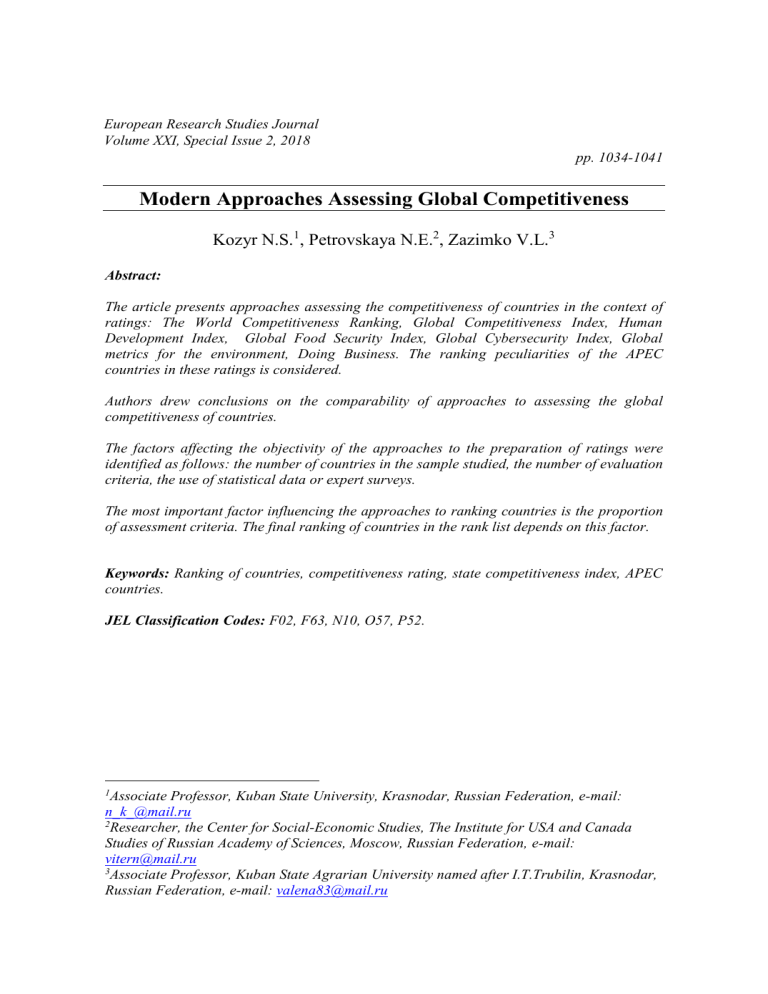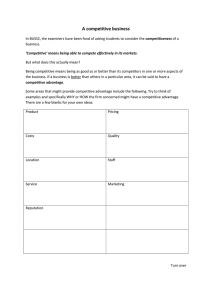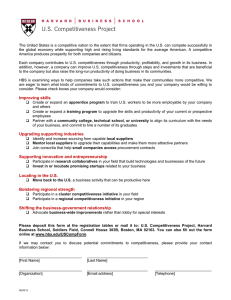
European Research Studies Journal Volume XXI, Special Issue 2, 2018 pp. 1034-1041 Modern Approaches Assessing Global Competitiveness Kozyr N.S.1, Petrovskaya N.E.2, Zazimko V.L.3 Abstract: The article presents approaches assessing the competitiveness of countries in the context of ratings: The World Competitiveness Ranking, Global Competitiveness Index, Human Development Index, Global Food Security Index, Global Cybersecurity Index, Global metrics for the environment, Doing Business. The ranking peculiarities of the APEC countries in these ratings is considered. Authors drew conclusions on the comparability of approaches to assessing the global competitiveness of countries. The factors affecting the objectivity of the approaches to the preparation of ratings were identified as follows: the number of countries in the sample studied, the number of evaluation criteria, the use of statistical data or expert surveys. The most important factor influencing the approaches to ranking countries is the proportion of assessment criteria. The final ranking of countries in the rank list depends on this factor. Keywords: Ranking of countries, competitiveness rating, state competitiveness index, APEC countries. JEL Classification Codes: F02, F63, N10, O57, P52. 1 Associate Professor, Kuban State University, Krasnodar, Russian Federation, e-mail: n_k_@mail.ru 2 Researcher, the Center for Social-Economic Studies, The Institute for USA and Canada Studies of Russian Academy of Sciences, Moscow, Russian Federation, e-mail: vitern@mail.ru 3 Associate Professor, Kuban State Agrarian University named after I.T.Trubilin, Krasnodar, Russian Federation, e-mail: valena83@mail.ru Kozyr N.S., Petrovskaya N.E., Zazimko V.L. 1035 1. Introduction Currently, numerous analytical agencies conducting a comprehensive assessment of countries in the framework of individual methodologies present their results. It should be noted that there is no universal methodology for ranking countries in terms of competitiveness (Dzhukha et al., 2017). The main reason is the unequal distribution of resources in the world. There are many ratings assessing the competitiveness of countries that are published by world organizations and private companies (Anureev, 2017). Global ratings are often criticized for objectivity in sample composition and ranking of countries. As part of this work, authors studied the set of the largest global rankings: The World Competitiveness Ranking (WCR), IMD World competitiveness center and Global Competitiveness Index (GCI) of the World Economic Forum (WEF). A review of the rankings of countries on certain aspects of competitiveness was also made: Human Development Index (HDI), Global Food Security Index (GFSI), Global Cybersecurity Index (GCI), Global metrics for the environment (EPI), World Bank Doing Business rating (DB). Each of the presented ratings differs in the focus of the study, the composition of the indicators, the scale of data collection, the number of countries in the sample. It is important to note that competitiveness ratings should resolve the main task of comparing countries according to the degree of sovereignty and the quality of life of citizens. High statistical indicators without an appropriate level of economic security and ensuring a high standard of living lose the meaning of ranking. Approaches to ranking countries are considered on the example of Asia-Pacific Economic Cooperation (APEC). The selection includes the countries of the West and the East; both economic development leaders and countries with low competitiveness indicators. The study is devoted to the analysis of existing ratings for comparability of data in terms of determining the level of competitiveness of countries. 2. Theoretical, empirical and methodological issues The article provides an overview of some of the international regular ratings of a comprehensive assessment of countries, which includes organizations that have developed ranking techniques and the year of the first report. The titles of the collections show the subject of the study of global competitiveness ratings. The number of countries analyzed in the reports is as of 2017. APEC competitiveness ranking includes 19 out of 21 states. The following countries, which are rarely represented in global rankings, are excluded: Papua New Guinea, Chinese Taipei. For example, Papua New Guinea, in accordance with the human Modern Approaches Assessing Global Competitiveness 1036 development index, is ranked 158th, the category is the poor level of human development. The information base of the research is the data of the organizations that have developed the indicators of countries' competitiveness, all information is presented in open access on official websites. 3. Results Global competitiveness ratings emerged in 1989, the number of analytical reports on the comparison of countries is many times greater than those presented in Table 1. Table 1. Review of the regular ratings of the global competitiveness of countries No. Index Organization Subject of research, year of first release, frequency Number of countries, 2017 1 WCR IMD World competitiveness center The World Competitiveness Yearbook, since 1989, annually 63 2 GCI World Economic (WEF) Forum The Global Competitiveness Report, since 1996, annually 137 3 HDI United Nations Development Programme Human Development Index, since 1990, annually 190 4 GFSI Economist Intelligence Unit 5 GCI 6 EPI 7 DB International Telecommunication Union Yale Center for Environmental Law and Policy World Bank The Global Food Security Index, since 2012, annually Global Cybersecurity Index, since 2014, annually The Environmental Performance Index, since 2008, 1 time in 2 years Doing Business, since 2002, annually 113 134 180 190 The most major studies are the World Competitiveness Ranking (WCR, 2017) and the Global Competitiveness Index (GCI, 2017). To compile ranking indicators, not only the network of analytical agencies around the world is used, but also the statistics of many other international organizations. In particular, IMD uses data from international organizations (IMF, World Bank, Organization for Economic Cooperation and Development (OECD), International Labor Organization (ILO), etc.), private consulting companies (CB Richard Ellis, Mercer HR Consulting, PricewaterhouseCoopers. etc.) as well as national sources through the network of partner institutions. Kozyr N.S., Petrovskaya N.E., Zazimko V.L. 1037 The WEF rating is based on globally accessible statistics. And the main source of information is the expert survey of the top management of each country. In 2017, the expert opinion of more than 15,000 people around the world was used for developing reports. Own strategic centers include four sectors: The Center for the Global Agenda; The Center for Global Strategies; The Center for Regional Strategies; The Center for Global Industries. The principal difference in approaches to assessing the competitiveness of countries is the quality of statistical information. WCR has the following structure: 2/3 of accurate data, 1/3 of expert surveys. GCI mainly consists of expert surveys. Analytical data are divided into 4 groups of factors, each of them contains 5 blocks of evaluation criteria. The second difference is in the number of countries analyzed over the past 10 years: the WCR study includes about 60 countries, the GCI contains data from about 140 countries. The techniques of these indices are comparable: similar factors are estimated and the total number of indicators is 250 and 340. The Global Competitiveness Index structure is somewhat similar to the IMD model, the difference is that only 3 factors are considered instead of 4, and 12 are instead of 20 criteria. The Human Development Index (HDI, 2016) assesses the competitiveness of countries since 1990. The basic idea of ranking is to assess the quality and level of human life. The concept of the index is significantly different from the ratings of global competitiveness, because The survey ranks countries into 4 categories: very high, high, medium, low HDI. The Food Security Index (GFSI, 2017) is compiled annually by the British analyst agency Economist Intelligence Unit since 2012 with the support of the American transnational company Dupon and applies to 113 countries of the world. Food security is a state in which the population of a particular country at any time has physical, social and economic access to enough food needed to meet their needs, maintain an active and healthy lifestyle. Until 2017, the methodology was built on the analysis of 28 indicators formed in three groups. In the 2017 report, another group was introduced - natural resources and sustainability, which makes possible assessing the impact of climate and natural resources on food security. However, the assessment of this group is conditional (not taken into account when calculating the composite indicator) and is corrective. All indicators have a rating from 0 to 100, where 100 is the highest category score calculated by weights in the consolidated rank. The distribution of weights by groups is uneven, which has a negative impact on the formation of the index. The Global Cybersecurity Index (GCI, 2017b) contains 25 indicators, which are divided into 5 blocks: Legal (3 indicators), Technical (6 indicators), Organizational (3 indicators), Capacity Building (8 indicators), Cooperation (5 indicators). In turn, Modern Approaches Assessing Global Competitiveness 1038 indicators are compiled on the basis of 157 simple questions. The study focuses on individual aspects of countries’ competitiveness. The index has few indicators, making it difficult to rank countries. Country rating is conditional. A distinctive feature of the competitiveness assessment approach is to answer the question: is the state ready to withstand the threat of cybersecurity? The main objective of the environmental performance index (EPI, 2017) is to reduce pressure on the environment, increase human health, rational use of natural resources, and promote the viability of ecological systems. The index is based on 24 indicators included in 10 groups for 180 countries and uses statistical data in its methodology. The main objects are the environment, which improves with the growth and prosperity of factors (40%) and the viability of the ecosystem, which falls under the burden of industrialization and urbanization (60%). The “Environment” section includes three groups of indicators, “Ecosystem resilience” seven groups. The weights of the indicators of this rating are the most balanced, although the groups themselves are unbalanced. The indicators have a rating from 0 to 100, where 100 is the highest score. Results are arranged into 10 groups, which are aggregated into two groups. The index places high demands on the statistics provided to ensure the highest comparability of indicators. The Doing Business ranking (DB, 2017) is a global study assessing the indicators of creating favorable conditions in the country for business development. A study is built on the basis of statistical data and legal acts regulating entrepreneurial activity. The basis is the performance indicators in the field of small and medium-sized businesses in 190 countries. It is the only index that evaluates the rule-making activity and is aimed at improving the regulatory and legal activities of countries without taking into account the political aspect. The methodology is based on the calculation of the average of ten target indicators: the simplicity and accessibility of registering enterprises, obtaining construction permits, connecting to the power supply system, registering property, lending, protecting investors, taxing, international trade, enforcing contracts, liquidating enterprises (Ivanova et al., 2017). It also highlights an additional criterion - labor market regulation. The calculation does not take into account a number of variables: macroeconomic policy, the quality of the infrastructure, the qualification of the workforce, currency fluctuations, security and the level of corruption. Each indicator includes indicies such as cost, time, number of procedures; Some indicators have indicies such as minimum capital, quality of administrative services and controls, information disclosure, transparency, and others. Finally, the rating includes 41 indicators. The advantage of the rating is a unique system for calculating each factor: a survey is conducted not for one but ten questionnaires that meet a separate criterion; The formula for calculating the total value of each indicator is also individual. The ranking of countries is carried out by the average indicator, however, it also displays the positions of countries for each of the ten indicators. A Kozyr N.S., Petrovskaya N.E., Zazimko V.L. 1039 significant drawback of the rating is that it is formed only in only one city of the country (in two cities for 11 countries), the largest business center. Approaches to the definition of the global competitiveness of countries are considered on the example of APEC (Table 2). The columns contain the ranking data of countries in accordance with the studied competitiveness indices according to 2017 data. Table 2. The ranking in the global indices of APEC`s countries No. APEC Members 1 2 3 4 5 6 7 8 9 10 11 12 13 14 15 16 17 18 19 The United States Singapore Hong Kong, China Japan New Zealand Canada Australia Malaysia People's Republic of China Republic of Korea Thailand Chile Indonesia Russia Brunei Darussalam Mexico Viet Nam The Philippines Peru Rankings WCR 4 3 1 26 16 12 21 24 18 29 27 35 42 46 46 51 55 56 72 GCI 2 3 6 9 13 14 21 23 27 26 32 33 36 38 48 41 55 HDI 8 11 12 20 9 9 2 62 90 17 93 42 110 50 31 74 116 115 84 GFSI 2 4 18 14 9 5 41 45 24 55 24 69 41 43 64 79 53 GCI 2 1 8 11 19 9 7 3 32 13 20 81 70 10 53 28 101 37 79 EPI 27 49 20 17 25 21 75 120 60 121 84 133 52 53 72 132 82 64 DB 8 2 4 34 1 22 15 23 78 5 46 57 91 40 72 47 82 99 54 Data on the competitiveness of countries for a number of indicators show significant differences in the approaches of ranking countries in global ratings. The United States has high rates in all ratings, with the exception of the environmental performance index - 20 points lower than the comparable level of competitiveness in other indicators. Singapore also has a low index in the environmental performance with high results in all other competitiveness ratings. Hong Kong has high rates of global competitiveness, while in some indices the state is not represented. Japan has a low index in this ranking, while the country is in the top-10 countries of the Global Competitiveness Index. According to the ratings, New Zealand and Canada have similar competitive indicators. It should be noted that New Zealand is ranked first in "Doing Business". Canada's performance is better in Global Food Modern Approaches Assessing Global Competitiveness 1040 Security and Global Cybersecurity. Australia is a leader in human development and is ranked 21st in terms of global competitiveness. Here, the objectivity of approaches to the ranking of countries is called into question, since the hypothesis about the paramount importance of the human potential criterion is violated. Malaysia has average global competitiveness, with the country ranked 3rd in the Global Cybersecurity Index. China has low figures in the ratings of Human Development Index (90th) and The Environmental Performance Index (120th). Republic of Korea in ranking has the best indicators of competitiveness in Doing Business, and the worst results in The Environmental Performance Index (60th). Thailand has the highest competitiveness index (ranked 20th in the Global Cybersecurity Index, while ranked 12st in The Environmental Performance Index. Chile’s best is the GFSI (24th), but low EPI (84th). Indonesia - GCI (36th), EPI (133rd). Russia has the best index in the Global Cybersecurity Index (ranked 10th). Brunei Darussalam and Vietnam are not included in the Global Competitiveness Index, while the rating includes 137 states. Mexico has the average performance in all ratings. The Philippines has a very low level of human development. Peru has poor rates of competitiveness for all ratings. In general, most of countries have a wide range of rankings for each rating. Stable low for all countries is The Environmental Performance Index. The study did not reveal a direct correlation between the ratings of global competitiveness and the human development index. 4. Conclusion Modern competitiveness rankings are a part of the macroeconomic policy of organizations that are engaged in relevant research. Approaches to defining global competitiveness do not reflect the real potential of countries. The following factors affect the objectivity of ratings: 1. The number of countries in the sample. A large number of countries make difficult creating criteria for comparability of competitiveness. A small number of countries makes impossible comparing the performance of economies of different countries. 2. The number of criteria. A large number of criteria makes it difficult to obtain data. A small number of criteria does not give a range for ranking countries. 3. Data for research. Accurate data quantify and make difficult obtaining a qualitative assessment of the criteria. Expert surveys allow identifying the qualitative characteristics of competitiveness, while reducing the reliability of the data. Kozyr N.S., Petrovskaya N.E., Zazimko V.L. 1041 It should be noted that the main factor that affects the approaches to determining the competitiveness of a country is the proportion of assessment criteria. This factor in each rating is set by the organization independently and is reflected in the rating methodology. In this regard, the use of the same indicators will give a different assessment of the state competitiveness depending on the degree of importance of the factors. References: Anureev, V.S. 2017. Reconfiguration of Financial System Elements to Restore Economic Growth: The System Simplicity and Transformation towards State-Based and Corporate-Based Types. European Research Studies Journal, 20(2A), 281-307. DB. 2017. Doing Business. Available at: http://www.doingbusiness.org/~/media/WBG/DoingBusiness/Documents/AnnualReports/English/DB17-Report.pdf. Dzhukha, M.V., Kokin, N.A., Li, S.A., Sinyuk, Yu.T. 2017. Research and Development Intensity in Business: Russia and EU. European Research Studies Journal, 20(1), 6476. EPI. 2017. Global metrics for the environment. Available at: http://epi.envirocenter.yale.edu/downloads/epi2018policymakerssummaryv01.pdf. GCI. 2017a. The Global Competitiveness Report. Available at: http://www3.weforum.org/docs/GCR20172018/05FullReport/TheGlobalCompetitivenessReport2017%E2%80%932018.pdf. GCI. 2017b. Global Cybersecurity Index. Available at: http://www.itu.int/en/ITUD/Cybersecurity/Documents/GCI-17Report.pdf. GFSI. 2017. Global Food Security Index. Available at: http://foodsecurityindex.eiu.com/. HDI. 2016. Human Development Index. Available at: http://hdr.undp.org/en/2016-report. Ivanova, A.E., Mackaev, M.M., Platonova, K.T., Elagina, V.N. 2017. Theoretical Basis for Composition of Economic Strategy for Industry Development. European Research Studies Journal, 20(1), 246-256. WCR. 2017. The World Competitiveness Yearbook. Available at: https://www.imd.org/research/books/world-competitiveness-yearbook-2017/.






